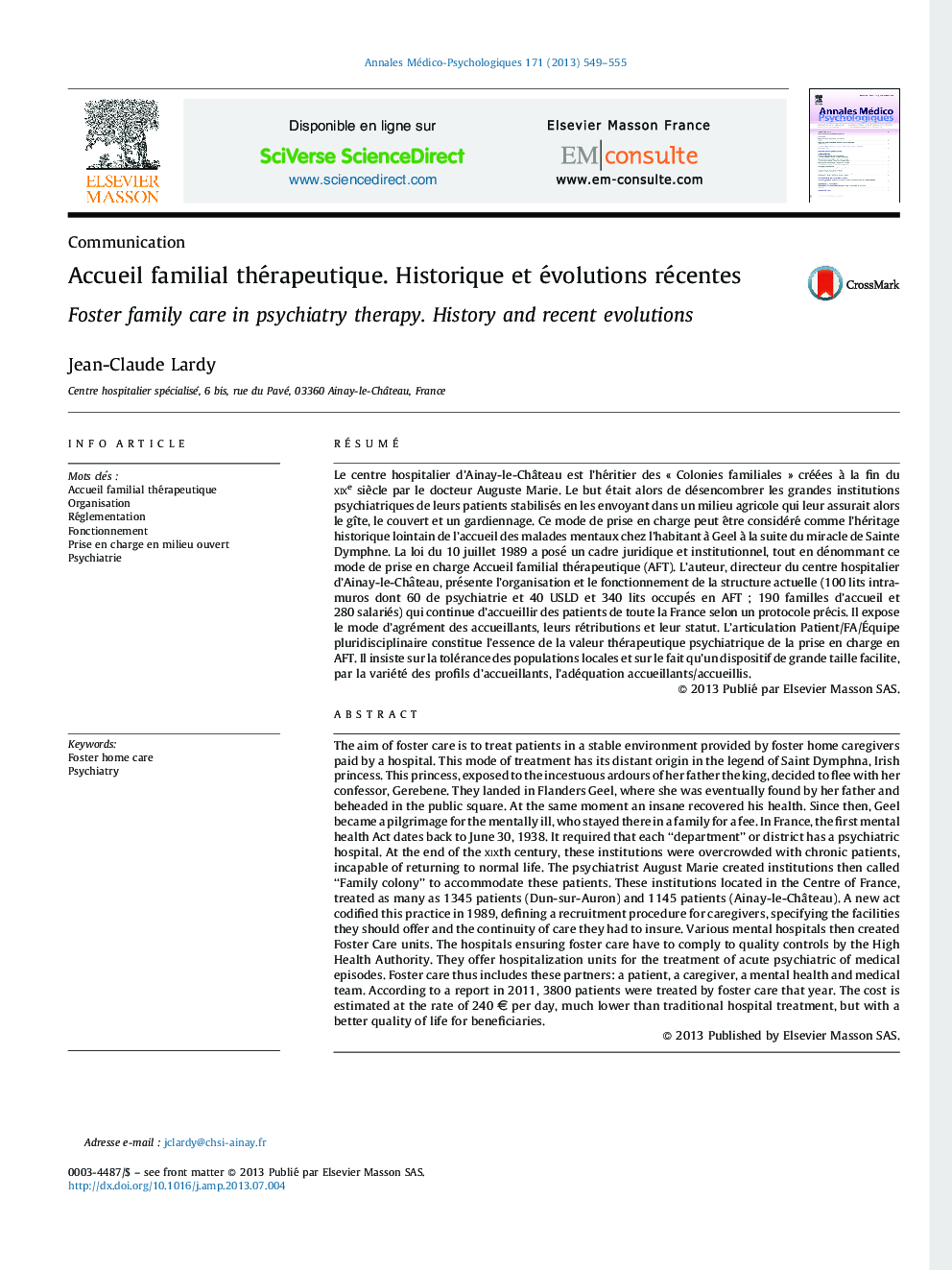| کد مقاله | کد نشریه | سال انتشار | مقاله انگلیسی | نسخه تمام متن |
|---|---|---|---|---|
| 314213 | 534581 | 2013 | 7 صفحه PDF | دانلود رایگان |

RésuméLe centre hospitalier d’Ainay-le-Château est l’héritier des « Colonies familiales » créées à la fin du xixe siècle par le docteur Auguste Marie. Le but était alors de désencombrer les grandes institutions psychiatriques de leurs patients stabilisés en les envoyant dans un milieu agricole qui leur assurait alors le gîte, le couvert et un gardiennage. Ce mode de prise en charge peut être considéré comme l’héritage historique lointain de l’accueil des malades mentaux chez l’habitant à Geel à la suite du miracle de Sainte Dymphne. La loi du 10 juillet 1989 a posé un cadre juridique et institutionnel, tout en dénommant ce mode de prise en charge Accueil familial thérapeutique (AFT). L’auteur, directeur du centre hospitalier d’Ainay-le-Château, présente l’organisation et le fonctionnement de la structure actuelle (100 lits intra-muros dont 60 de psychiatrie et 40 USLD et 340 lits occupés en AFT ; 190 familles d’accueil et 280 salariés) qui continue d’accueillir des patients de toute la France selon un protocole précis. Il expose le mode d’agrément des accueillants, leurs rétributions et leur statut. L’articulation Patient/FA/Équipe pluridisciplinaire constitue l’essence de la valeur thérapeutique psychiatrique de la prise en charge en AFT. Il insiste sur la tolérance des populations locales et sur le fait qu’un dispositif de grande taille facilite, par la variété des profils d’accueillants, l’adéquation accueillants/accueillis.
The aim of foster care is to treat patients in a stable environment provided by foster home caregivers paid by a hospital. This mode of treatment has its distant origin in the legend of Saint Dymphna, Irish princess. This princess, exposed to the incestuous ardours of her father the king, decided to flee with her confessor, Gerebene. They landed in Flanders Geel, where she was eventually found by her father and beheaded in the public square. At the same moment an insane recovered his health. Since then, Geel became a pilgrimage for the mentally ill, who stayed there in a family for a fee. In France, the first mental health Act dates back to June 30, 1938. It required that each “department” or district has a psychiatric hospital. At the end of the xixth century, these institutions were overcrowded with chronic patients, incapable of returning to normal life. The psychiatrist August Marie created institutions then called “Family colony” to accommodate these patients. These institutions located in the Centre of France, treated as many as 1345 patients (Dun-sur-Auron) and 1145 patients (Ainay-le-Château). A new act codified this practice in 1989, defining a recruitment procedure for caregivers, specifying the facilities they should offer and the continuity of care they had to insure. Various mental hospitals then created Foster Care units. The hospitals ensuring foster care have to comply to quality controls by the High Health Authority. They offer hospitalization units for the treatment of acute psychiatric of medical episodes. Foster care thus includes these partners: a patient, a caregiver, a mental health and medical team. According to a report in 2011, 3800 patients were treated by foster care that year. The cost is estimated at the rate of 240 € per day, much lower than traditional hospital treatment, but with a better quality of life for beneficiaries.
Journal: Annales Médico-psychologiques, revue psychiatrique - Volume 171, Issue 8, September 2013, Pages 549–555